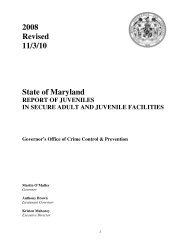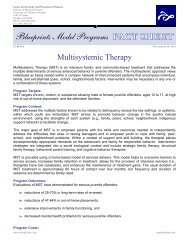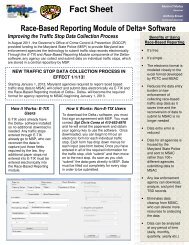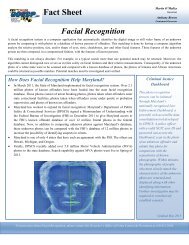Targeted Outreach - Governor's Office of Crime Control & Prevention ...
Targeted Outreach - Governor's Office of Crime Control & Prevention ...
Targeted Outreach - Governor's Office of Crime Control & Prevention ...
You also want an ePaper? Increase the reach of your titles
YUMPU automatically turns print PDFs into web optimized ePapers that Google loves.
ii<br />
<strong>Targeted</strong> <strong>Outreach</strong><br />
4. Providing individualized case management<br />
across four areas (law enforcement/juvenile justice,<br />
school, family and Club) to target youth to<br />
decrease gang-related behaviors 1 and contact<br />
with the juvenile justice system, and to increase<br />
the likelihood that they will attend school and<br />
show improved academic success.<br />
Because one approach is preventive and the other an<br />
intervention with youth who are already exhibiting<br />
gang behaviors, these components translated into different<br />
implementation strategies in the two initiatives.<br />
For example, the youth in the intervention project<br />
need different services (e.g., drug treatment, tattoo<br />
removal, job training, educational services), than<br />
those in the prevention group. Therefore, the organizations<br />
with whom Clubs develop their network would<br />
also differ. Further, prevention youth mainstreaming<br />
into Club programming is immediate, whereas it<br />
occurs much later for a hard-core gang member or<br />
youth who has been entrenched in the gang lifestyle<br />
and negative behaviors. Nevertheless, each <strong>of</strong> the four<br />
components is a building block for the success <strong>of</strong><br />
both the intervention and prevention initiatives.<br />
A major component <strong>of</strong> both GPTTO and GITTO is<br />
the Clubs’ attention to recruitment <strong>of</strong> hard-to-reach<br />
youth. Club staff develop strategies to draw in youth<br />
who have not typically been involved in productive<br />
after-school activities and those who might not have<br />
joined the Club without some external encouragement.<br />
Youth are identified and recruited through<br />
direct outreach and referrals from such resources as<br />
school personnel, social service agencies, police and<br />
probation. The prevention model recruits youth into<br />
local Boys & Girls Clubs to participate in all aspects <strong>of</strong><br />
Club programming. The intervention model recruits<br />
youth to participate in a project that is staffed by Boys<br />
& Girls Clubs, but is run separately (either after typical<br />
Club hours or on a more one-on-one case management<br />
basis) from daily Club activities.<br />
Studies show that Boys & Girls Clubs serve at-risk<br />
youth and provide them with important positive<br />
developmental supports (Gambone and Arbreton,<br />
1997; Feyerherm et al., 1992). Other studies have<br />
called the GPTTO and GITTO approaches promising<br />
(Esbensen, 2000; Howell, 2000). Their emphasis<br />
on community mobilization, recruitment <strong>of</strong> highrisk<br />
youth, new programming strategies and case<br />
management reflect a shift in Club philosophy and<br />
implementation. Implementing the GPTTO or<br />
GITTO approach at a Club changes the culture <strong>of</strong><br />
the Club—how it works with other agencies, how it<br />
thinks about recruitment and the youth it serves,<br />
how programming is designed and implemented,<br />
its hours <strong>of</strong> operation, how staff interact with youth,<br />
and the level <strong>of</strong> documentation maintained about<br />
individual youth.<br />
Because the approaches undertaken by each Club<br />
are designed within the framework <strong>of</strong> the four components<br />
<strong>of</strong> GPTTO and GITTO (and their intended<br />
outcomes), there are many similarities among the<br />
Clubs and how they operate their initiatives. Because<br />
the Clubs’ communities, gang problems, resources<br />
and infrastructure differ, there is not one specific<br />
way to implement GPTTO or GITTO; therefore,<br />
there is no single model or program. Clubs themselves<br />
identify the specifics: target populations they<br />
will serve given the risk factors prevalent for gangs in<br />
their area; the community agencies with which they<br />
will collaborate; and the programming they will <strong>of</strong>fer<br />
based on the needs and interests <strong>of</strong> the groups <strong>of</strong><br />
youth they serve. Because there is no single, specific<br />
model, we describe the approaches the Clubs take to<br />
address the four components <strong>of</strong> the initiatives.<br />
The Evaluation<br />
In 1997, with funding from OJJDP and The Pinkerton<br />
Foundation, P/PV embarked on an evaluation <strong>of</strong><br />
GPTTO and GITTO. The aims <strong>of</strong> the study were:<br />
• To learn if the Clubs succeeded at attracting<br />
youth at high risk <strong>of</strong> gang involvement;<br />
• To discover if the Clubs could keep GPTTO<br />
and GITTO youth participating at the Club or<br />
program;<br />
• To determine if GITTO and GPTTO youth<br />
were indeed receiving positive supports through<br />
their participation in the Club; and<br />
• To assess if participation had a positive effect on<br />
the lives <strong>of</strong> GPTTO and GITTO youth.<br />
The specific outcomes <strong>of</strong> interest to BGCA and pursued<br />
in this evaluation were decreased levels <strong>of</strong> gang<br />
behaviors, decreased contact with the juvenile justice<br />
system, and increased levels <strong>of</strong> academic achievement<br />
and positive school behaviors. We also wanted<br />
to understand what worked for Clubs implementing

















